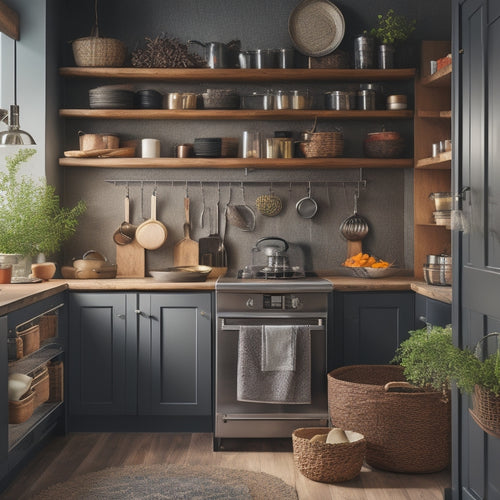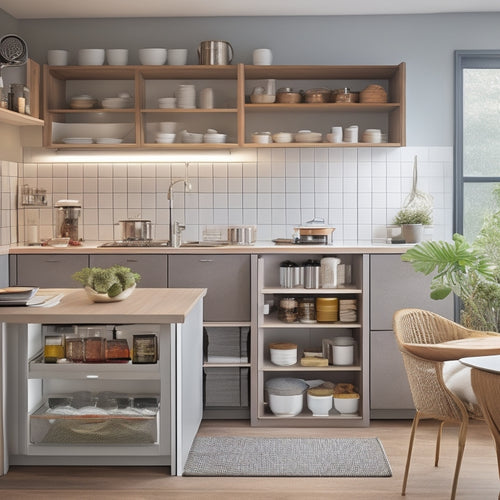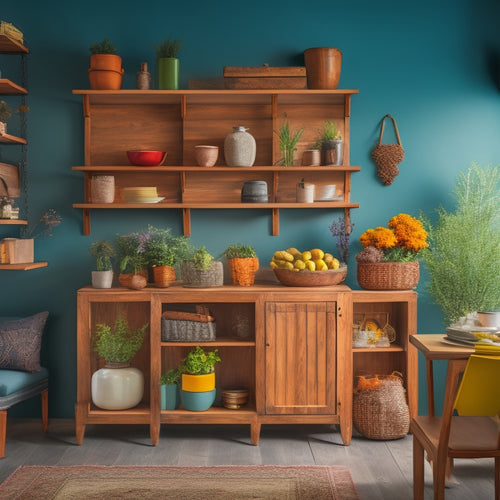
Why Small Kitchens Need Strategic Utensil Storage
Share
You're tired of cluttered countertops and disorganized drawers in your small kitchen. The truth is, you need a strategic plan for storing utensils. Without it, your kitchen becomes a chaotic mess, making meal prep a nightmare. By categorizing utensils, implementing clutter control measures, and utilizing vertical storage options, you can create a more efficient and organized space. Designating a utensil station and selecting multifunctional utensils can also help streamline your cooking process. By implementing these strategies, you'll be well on your way to a more functional kitchen - and there's more to learn about how to optimize your space.
Key Takeaways
• Strategic utensil storage is crucial in small kitchens to maximize limited space and maintain organization.
• Clutter control measures, like categorizing and grouping utensils, help reduce chaos and increase efficiency.
• Utilizing vertical storage options, such as wall shelves and pegboards, optimizes storage capacity and keeps frequently used items accessible.
• Designating a utensil station with multifunctional tools streamlines meal prep and reduces clutter.
• By implementing these strategies, small kitchens can overcome storage challenges and become more functional and efficient.
Utensil Chaos in Small Spaces
In your cramped kitchen, a jumble of utensils spills out of drawers and countertops, making meal prep a frustrating obstacle course. You're not alone - many small kitchens struggle with utensil chaos. But fear not, there are space saving solutions and organization tips to tame the mess.
Start by categorizing your utensils into groups, such as baking, cooking, and serving. This will help you determine what you need immediate access to and what can be stored away.
Next, implement clutter control measures like a utensil organizer or a pegboard on the wall. These storage hacks will keep frequently used items within easy reach, freeing up counter space for more important tasks.
Consider a drawer divider or a utensil tray to keep items inside drawers organized and prevent them from getting jumbled again.
Maximizing Cabinet Storage Potential
Since you've organized the countertops and drawers, it's time to discover the full storage potential of your cabinets, where you can stash less-frequently used items and keep them out of the way. Cabinets are often underutilized, but with the right strategies, they can become a treasure trove of storage.
Start by evaluating what you need to store and grouping similar items together. Install space-saving racks or shelves to maximize vertical space and keep items off the floor. You can also use drawer dividers to separate items within a cabinet, making it easier to find what you need.
Don't forget about the often-wasted space on the back of cabinet doors. Over-the-door hooks or hanging baskets can hold infrequently used items like special occasion dishes, lids, or even cleaning supplies. By utilizing these hidden areas, you'll be amazed at how much more storage you can squeeze out of your cabinets.
With a little creativity and planning, you can turn your cabinets into a storage powerhouse, freeing up space in other areas of your kitchen.
Utilizing Vertical Storage Options
You can discover even more storage potential in your small kitchen by exploiting the often-overlooked vertical space above your countertops and appliances. By doing so, you'll create a more organized and efficient cooking environment.
Consider installing wall shelves or hanging hooks to store infrequently used items like special occasion dishes or cookbooks. This will keep them out of the way but still easily accessible.
For smaller items like spices, oils, or utensils, utilize magnetic strips or under shelf storage. These solutions are perfect for maximizing the often-wasted space beneath your shelves or above your countertops.
With magnetic strips, you can store metal items like spices or oils, keeping them organized and within reach. Under shelf storage, on the other hand, is ideal for storing utensils, plates, or bowls, freeing up valuable cabinet space.
Designating a Utensil Station
Designate a specific area of your kitchen as a utensil station to keep frequently used items within easy reach, freeing up valuable storage space and streamlining your cooking workflow. This strategic spot can be a countertop, a wall-mounted board, or even a dedicated drawer. By designating a utensil station, you'll reduce clutter and make meal prep more efficient.
Here's an example of what your utensil station could look like:
| Column 1 | Column 2 | Column 3 |
|---|---|---|
| Utensil Holder | Spice Rack | Recipe Board |
| Frequently Used Utensils | Oils and Vinegars | Meal Planning Calendar |
| Kitchen Shears | Salt and Pepper | Notes and Reminders |
Selecting Multifunctional Utensils
Five essential multifunctional utensils can replace a dozen single-purpose tools, freeing up valuable storage space in your small kitchen. By choosing the right space-saving tools, you'll be able to cook, serve, and store with ease.
Consider investing in a silicone spatula that doubles as a scraper, a pair of kitchen shears that can also open packaging, or a chef's knife with a built-in sharpener. These innovative storage solutions will help you make the most of your kitchen's limited real estate.
When selecting multifunctional utensils, prioritize practicality and style. Look for tools that are both aesthetically pleasing and highly functional. A stylish set of measuring spoons with built-in leveling tools or a compact garlic press that also minces herbs can elevate your cooking game while keeping your kitchen organized.
Implementing a "Home for Each"
Your utensils are only as organized as the system you create to store them, so establish a designated spot for each tool to maintain a clutter-free kitchen. This mindset is key to achieving organizational efficiency and effective space management in your small kitchen. By assigning a 'home' for each utensil, you'll reduce clutter and make the most of your available storage space.
Start by categorizing your utensils into groups, such as baking, cooking, and serving tools. Then, identify the most convenient and accessible storage solutions for each group.
For example, you might store frequently used items in easy-to-reach drawers or on a countertop utensil organizer, while less frequently used items can be stored in higher or harder-to-reach areas.
Creating a Functional Workflow
By optimizing the physical arrangement of your utensils, you'll create a seamless operation that streamlines meal prep and cooking in your small kitchen. This means positioning frequently used items in easy-to-reach locations, allowing you to effortlessly shift between tasks. Consider space-saving solutions like wall-mounted utensil holders or a utensil organizer near your cooking station.
Efficient organization is key to a functional operation. Group similar items together, such as all baking utensils in one area, and assign a specific spot for each item. This ergonomic design ensures that you're not constantly searching for the right tool, saving you time and reducing frustration.
Workflow optimization is essential in a small kitchen, where every inch counts. By thoughtfully arranging your utensils, you'll be able to prepare meals quickly and efficiently, making the most of your limited space.
With a well-designed operation, you'll be able to focus on what matters most – serving delicious meals to your loved ones.
Frequently Asked Questions
Can I Store Utensils in a Decorative Vase or Jar?
You can definitely store utensils in a decorative vase or jar, using creative solutions to optimize space. Just make sure it's clean, dry, and easily accessible, and you'll be serving up a stylish and functional solution!
How Often Should I Clean and Maintain Utensil Storage?
'When it rains, it pours' - don't let utensil storage become a cluttered mess! You should clean and maintain your utensil storage regularly, ideally every 1-2 weeks, to guarantee frequency of cleaning and upkeep, keeping your organization on track.
Are Utensil Organizers Compatible With Non-Standard Cabinet Sizes?
You'll find that many utensil organizers offer custom solutions or adjustable options to fit non-standard cabinet sizes, allowing you to optimize space and utilize drawer dividers for a seamless fit.
Can I Repurpose Old Furniture for Utensil Storage?
You can breathe new life into old furniture by repurposing it for utensil storage, and get creative with containers like vintage suitcases, wicker baskets, or metal crates to add a personal touch.
Do Utensil Storage Solutions Work for Left-Handed People?
As a left-handed person, you'll find that many utensil storage solutions cater to your needs, offering left-handed adaptations and ergonomic utensil holders that guarantee usability, making cooking and serving a breeze.
Related Posts
-

Over-The-Door Kitchen Storage for Apartment Living
Over-the-door kitchen storage is a smart solution for apartment living, allowing you to maximize vertical space while...
-

Space-Saving Kitchen Solutions for Busy Homeowners
To maximize your kitchen's potential, start with vertical storage solutions like wall-mounted shelves and pegboards f...
-

Creative Corner Cabinet Space Management
Creative corner cabinet space management turns neglected nooks into stunning storage solutions. You can maximize vert...


